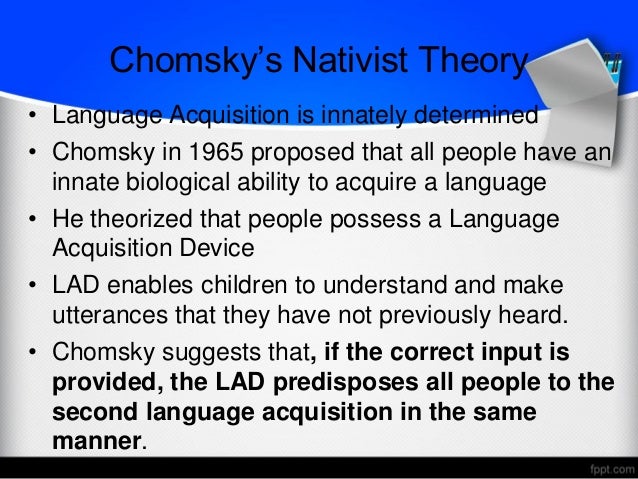First Language Acquisition 3 2 Chomsky’s Innateness Hypothesis 2.1 Chomsky’s Argument for Innate knowledge of Language Chomsky (2004, 17) argues that children’s ability to learn language is due to a genetically programmed organ that is located in the brain. Once children are born. The Language Acquisition Device (LAD) is a hypothetical module of the human mind posited to account for children's innate predisposition for language acquisition. 1 First proposed by Noam Chomsky in the 1960s, the LAD concept is an instinctive mental capacity which enables an infant to acquire and produce language. Sep 16, 2018 Language Acquisition Device: The Language Acquisition Device (LAD) is a hypothetical module of the human mind posited to account for children's innate predisposition for language acquisition. It was first proposed by Noam Chomsky. He was an American linguist, philosopher, cognitive scientist, historian, and social critic. LANGUAGE ACQUISITION: THEORETICAL BACKGROUND Language is one of the prized possessions of human beings. It makes us the building blocks essential for any form of communication. It is the main vehicle by which we know about other people's thoughts. Possessing a language.

Noam Chomsky. Hallmark card studio for mac. Noam Chomsky is perhaps the best known and the most influential linguist of the second half of the Twentieth Century. He has made a number of strong claims about language: in particular, he suggests that language is an innate faculty - that is to say that we are born with a set of rules about language in our heads which he refers to as the 'Universal Grammar'.
| Part of a series on |
| Linguistics |
|---|
| Portal |
The Language Acquisition Device (LAD) is a theoretical component of the [[individuals thought].[1]

First proposed by Noam Chomsky in the 1960s, the LAD concept is an instinctive mental capacity which enables an infant to acquire and produce language. It is a component of the nativist theory of language. This theory asserts that humans are born with the instinct or 'innate facility' for acquiring language. The main argument in favor of the LAD is the argument from the poverty of the stimulus, which argues that unless children have significant innate knowledge of grammar they would be unable to learn language as quickly as they do, given that they never have access to negative evidence and rarely received direct instruction in their first language.[2]
A summary explaining LAD by Chomsky states languages are infinite pertaining to the sequence of word forms (strings) and grammar. Then these word forms organize grammatically correct sequences of words that can be pooled over a limited lexicon of each independent language. So, LAD is tasked to select from the infinite grammars that is then correct for the language that is presented to an individual, for example, a child. However, Chomsky’s ideas lead to the problems such as, how can LAD pick which grammar is correct for a given language, the idea of poverty of negative evidence addressed by Brian MacWhinney, and innate universal grammar, error-free learning, to name a few.[3]
MacWhinney, focusing on poverty of negative evidence, argues that there is not enough evidence to support error-free learning and an existence of a universal grammar posed by Chomsky. This system, would be “predictive” if built, thus in doing so a set LAD would embody a universal grammar that is also set.[4]
References[edit]
- ^Chomsky 1965, p. 25.
- ^VanPatten & Benati 2010, p. 101.
- ^Hausser, Roland (2004). 'What if Chomsky were right?'. Journal of Child Language. 31 (4): 919–922. CiteSeerX10.1.1.543.4281. doi:10.1017/S030500090400635X – via Cambridge University Press.
- ^Macwhinney, Brian. 'A multiple process solution to the logical problem of language acquisition'. Journal of Child Language. 31 (4): 883–914. doi:10.1017/S0305000904006336. PMC1876779 – via Cambridge University Press.
Sources[edit]
Chomsky Language Acquisition Device
- Briscoe, Ted (2000). 'Grammatical Acquisition: Inductive Bias and Coevolution of Language and the Language Acquisition Device'. Language. 76 (2): 245–296. CiteSeerX10.1.1.41.5863. doi:10.1353/lan.2000.0015.
- Chomsky, Noam (1965). Aspects of the Theory of Syntax. MIT Press.
- Kennison, S. M. (2013). Introduction to language development. Los Angeles: Sage.
- VanPatten, Bill; Benati, Allesandro G. (2010). Key Terms in Second Language Acquisition. Continuum.